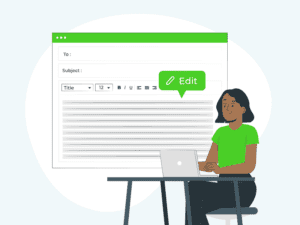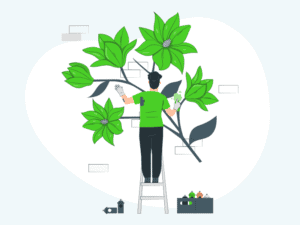When someone signs up for your email list, you need to harness the momentum right away to maximize the chance of making a sale. Long-term subscribers have already seen everything you have to offer. If they haven’t been convinced by now, what’s going to change their mind?
This is where the welcome email series shines. Here’s how you create one that you can send out from your automated platform.
Welcome series emails: The facts
Did you know that…
- Welcome emails result in 320% more revenue per email than other promo emails.
- The average open rate for a welcome email is 82%. Other emails are at 21%.
- Subscribers who receive a welcome email engage up to 33% more with a brand.
- Welcome emails that contain an offer can boost revenue by up to 30%.
Even so, 41% of brands don’t send a welcome email in the first 48 hours and only 39% of brands send a welcome email at all. To make matters worse, 27% of brands don’t send any emails in the first three weeks.
Establishing the goal of your welcome email series
Before you create your emails, you first need to establish your goals.
Common goals
- To convert first-time buyers.
- To cross sell or upsell to existing customers.
- To encourage them to schedule an appointment.
- To provide more information.
- To build your community.
- To get testimonials/feedback.
With your goal set, it’s generally recommended to send between four and six emails. This is enough to give value and nurture your leads before the offer, but not enough to annoy them and boost your “unsubscribes.”
For this post, we’re going to outline five best practices for emails designed to convert first-time buyers. (Watch out for the bonus tip at the end!)
Honing in on your strategy
Imagine your email series as a countdown to lift off. With every email, it should ideally go: 5, 4, 3, 2, 1… sale!
As people move along the funnel, they are going to care about different things and you need to address those concerns at the right moment.
For example, imagine it’s the first email. Your prospect will be aware of who you are (because they’ve signed up) but they aren’t going to know much else about you. By offering them a deal right away, you’re just going to chase them off. They simply aren’t ready to hear it.
That’s why you need to nurture them.
What each email should contain

Now we get down to the nuts and bolts of it. Here’s how you create a welcome email series that converts.
5… Email one: Welcome email
The first email in your series is the one where you actually do the welcoming. After all, it’s called a “welcome email series.” But that’s not the only thing it should contain. You should also:
- Provide a link to your lead magnet. (What made them sign up)
- Segment your audience. (Do this using your CRM!)
- Define expectations.
Keep an eye out for the first email that comes in after you sign up for something. What does it say? What do you like about it? What could you improve?
4… Email two: Selling the perfect world
How would your sales benefit if you were able to execute a perfect welcome email campaign?
Sorry to use you as a guinea pig, but this question is an example of us selling the perfect world to you. We haven’t mentioned the product or solution that we offer at Pipeline.so.
Because it’s not about us yet. It’s about the solution that will make your life easier. Of course, we hope that once you realize you need the solution, you’ll trust us at a later point and make a purchase. But at the same time, you could easily go elsewhere and find another solution.
At this stage, it’s only about the prospect and their perfect world. Keep this in mind as you create the email.
3… Email three: One more thing…
Anyone out there remember the classic detective TV show Columbo?
Played by actor Peter Faulk, the fictional lieutenant would talk to the murderers as if he was just generally asking for information. His friendly approach was disarming and he would lull them into a false sense of security. Then, just as he was about to leave, he would jump in with his classic line, “Oh, before I go, just one more thing…”
That’s when he had them.
There’s something we can learn from the Columbo method. No, there’s no murders or trickery involved. Just as Columbo knew they committed the murder, we already know our product will help our target—but they aren’t ready for the hard sell yet. Instead, you need to guide them towards that realization themselves.
Once the time is right, we hit them with the “Oh, and one more thing… Our product can help you.”
The softest sell imaginable. Just at the end.
2… Email four: Painting in the details

Remember the “selling the perfect world” email? If that was a painting, we could say it was an impressionist work. You were giving someone the general idea of what their life would be like if they had the solution.
But that’s all it was… An impression. Now it’s time to get hyper-realistic.
After the soft sell above, your target should be aware of your product. But they may not know if it’s right for them. That means you need to sell them on the benefits.
One of the best ways to think about benefits is in terms of time. Whatever your product or service is, it’s a good exercise to sit down and fill in these sentences with as many benefits as you can think of.
- Immediately after purchase, the customer will…
- One week after purchase, the customer will…
- One month after purchase, the customer will…
- One year after purchase, the customer will…
- Five years after purchase, the customer will…
Don’t worry if you can’t think of many for each one. Some products and services have more short-term than long-term benefits. But do your best!
Once you have the benefits down, the next question is how do you present it?
Begin like the impressionist painting where you sell the perfect world in an abstract way. Then, begin slowly adding in details from immediately after the purchase, a month after, five years after, and so on.
The overall effect is for the reader to fully see how your product will change their life both immediately and on an ongoing basis. That’s powerful stuff.
1… Email five: Lift off!

The moment has finally come. If everything’s gone to plan, your target should be primed and ready to see what kind of deal you can give them.
Now you have to decide what kind of hard sell you want to do. Generally speaking, you’ll need something that inspires them to act now. There are a few ways you can do that:
- Create a sense of urgency.
- Make an offer.
- Combine an offer with a sense of urgency.
In most cases, you’ll be doing both.
You can be straightforward or creative with this type of email. We’ll leave it up to your judgment. While you should always be true to your brand voice, the prospect should be ready to hear what you have to say.
There’s no need to tread too softly now. If they’ve been properly nurtured, they will simply want to see how good your offer is.
0… Bonus email: The follow-up
And now we get to the final bonus tip—the follow-up email. This is simply a last final nudge for those who were about to make a purchase but never quite took the leap.
Again, we’d recommend keeping this one short and sweet. But that doesn’t mean it shouldn’t be highly valuable. The idea is to ramp up the sense of urgency with a true “last chance reminder.”
And this time you mean it.
Whatever offer you had will expire soon.
Don’t miss out. Act now.
And don’t be afraid to let them know exactly what they’ll be missing out on. A good way to do this is by using the most effective bottom-funnel content a sales or marketing professional can use—testimonials. This is often the final nudge they need to actually convert.

